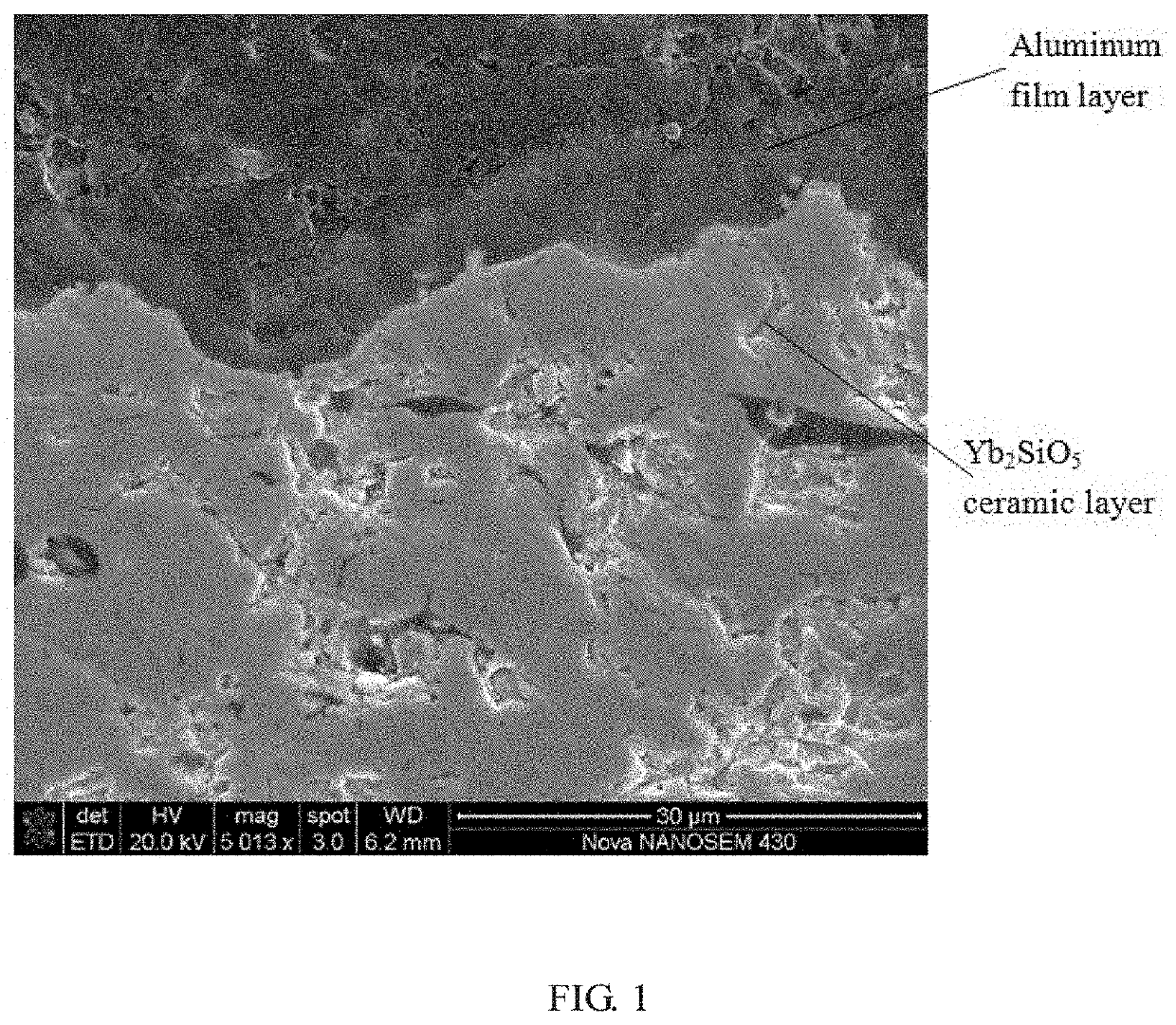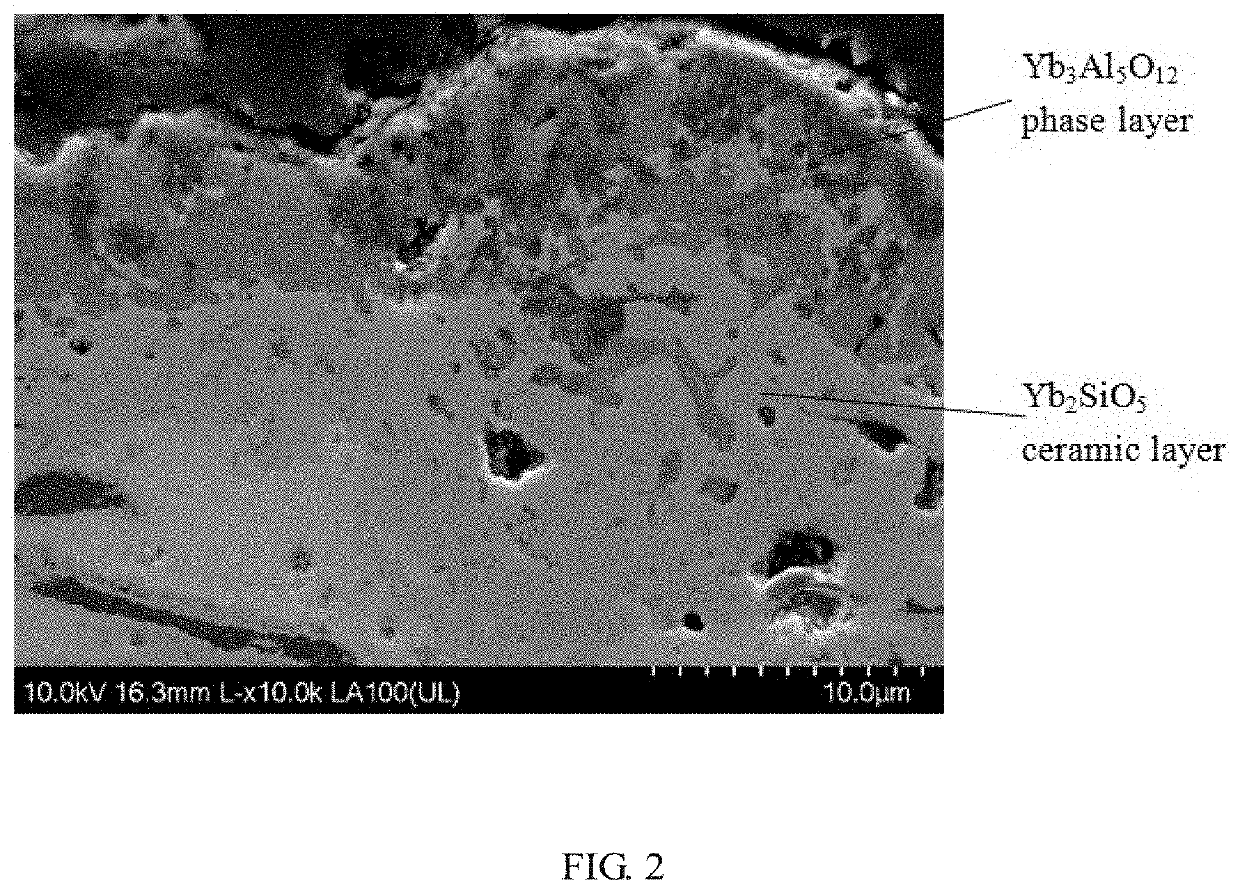Method for coating thermal/environmental barrier coating
a technology of thermal/environmental barrier and coating, which is applied in the direction of superimposed coating process, vacuum evaporation coating, coating, etc., can solve the problems of sharp deterioration of the surface stability of sic ceramic matrix composite, increase in the temperature of fuel gas in the aero-engine, and increase in the surface temperature of the hot-end components of the high-pressure turbin
- Summary
- Abstract
- Description
- Claims
- Application Information
AI Technical Summary
Benefits of technology
Problems solved by technology
Method used
Image
Examples
embodiment 1
[0073]The method for coating an environmental barrier coating provided by this embodiment includes the following operating steps:
[0074]preparing a Si coating, a mullite coating, and a Yb2SiO5 coating on the surface of silicon carbide-based composite substrate by using air plasma spraying, with the coatings successively having thicknesses of 50 μm, 50 μm and 80 μm;
[0075]preparing an aluminum film layer with a thickness of 3μm on the surface of the Yb2SiO5 coating by using the magnetron sputtering, wherein the conditions of the magnetron sputtering are as follows: a magnetron target current of 3 A and a bias voltage of 150 V;
[0076]heat treating the Yb2SiO5 coating deposited with the aluminum film layer, wherein the conditions of heat treatment are as follows: 800° C. kept for 2 h, 1300° C. kept for 24 h, a temperature raising rate of 5° C. / min, and a vacuum oxygen partial pressure less than 2×10−3 P; and
[0077]cooling to a room temperature, to obtain the environmental barrier coating o...
embodiment 2
[0078]The method for coating an environmental barrier coating provided by this embodiment includes the following operating steps:
[0079]preparing a Si coating, a mullite coating, and a Yb2SiO5 coating on the surface of silicon carbide-based composite substrate by using plasma spraying-physical vapor deposition, with the coatings successively having thicknesses of 50 μm, 50 μm and 80 μm;
[0080]preparing an aluminum film layer with a thickness of 3 μm on the surface of the Yb2SiO5 coating by using the magnetron sputtering, wherein the conditions of the magnetron sputtering are as follows: a magnetron target current of 3 A and a bias voltage of 150 V;
[0081]heat treating the Yb2SiO5 coating deposited with the aluminum film layer, wherein the conditions of heat treatment are as follows: 700° C. kept for 2 h, 1300° C. kept for 24 h, a temperature raising rate of 10° C. / min, and a vacuum oxygen partial pressure less than 2×10−3 Pa; and
[0082]cooling to a room temperature, to obtain the enviro...
embodiment 3
[0083]The method for coating an environmental barrier coating provided by this embodiment includes the following operating steps:
[0084]preparing a Si coating, a mullite coating, and a Yb2SiO5 coating on the surface of silicon carbide-based composite substrate by using plasma spraying-physical vapor deposition, with the coatings successively having thicknesses of 50 μm, 50 μm and 80 μm;
[0085]preparing an aluminum film layer with a thickness of 2 μm on the surface of the Yb2SiO5 coating by using the magnetron sputtering, wherein the conditions of the magnetron sputtering are as follows: a magnetron target current of 3 A and a bias voltage of 150 V;
[0086]heat treating the Yb2SiO5 coating deposited with the aluminum film layer, wherein the conditions of heat treatment are as follows: 700° C. kept for 2 h, 1350° C. kept for 20 h, a temperature raising rate of 10° C. / min, and a vacuum oxygen partial pressure less than 2×10−3 Pa; and
[0087]cooling to a room temperature, to obtain the enviro...
PUM
| Property | Measurement | Unit |
|---|---|---|
| thickness | aaaaa | aaaaa |
| temperature | aaaaa | aaaaa |
| bias voltage | aaaaa | aaaaa |
Abstract
Description
Claims
Application Information
 Login to View More
Login to View More - R&D
- Intellectual Property
- Life Sciences
- Materials
- Tech Scout
- Unparalleled Data Quality
- Higher Quality Content
- 60% Fewer Hallucinations
Browse by: Latest US Patents, China's latest patents, Technical Efficacy Thesaurus, Application Domain, Technology Topic, Popular Technical Reports.
© 2025 PatSnap. All rights reserved.Legal|Privacy policy|Modern Slavery Act Transparency Statement|Sitemap|About US| Contact US: help@patsnap.com


